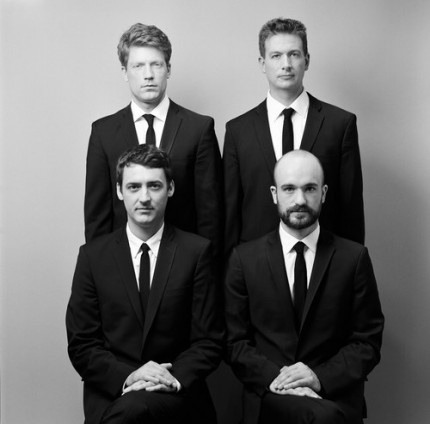Calder Quartet brings clarity and commitment to music old and new

The Calder Quartet performed Friday night at Jordan Hall, an event presented by the Celebrity Series.
Since its founding in the late 90s, the Calder String Quartet has developed a sterling reputation for its wide-ranging programming and championing of contemporary music. Friday night at Jordan Hall, in a concert presented by the Celebrity Series, the ensemble performed a customarily bracing program that paired quartets by Beethoven and Ravel with works by Andrew Norman and Thomas Adès.
The young members of the quartet—violinist Benjamin Jacobson, violinist Andrew Bulbrook, violist Jonathan Moerschel, and cellist Eric Byers—play with crystalline communication. Theirs is a clear, uniformly blended, and transparent ensemble sound that is capable of changing colors on a dime.
Those qualities were apparent in the opener, Andrew Norman’s Sabina for string quartet.
The inspiration for Sabina came from an experience the composer had in Rome in 2006. While visiting the Basilica of Santa Sabina just before daybreak, he was transfixed by the shifting patterns of light on the church’s stone walls.
Norman captured those visions in a luminous score. Sabina begins with razor-thin harmonics in the cello, which are then echoed in the viola. These sounds quickly expand into waving gestures for the full ensemble, the open fifths and octaves gradually swelling to a cascade of shimmering effects, like light scattered through a prism. By work’s end, these gestures break into long, glacial phrases that freeze on close seconds and unisons. The Calder members treated each line of Sabina with intensity and a singing lyricism to make a strong case for work that deserves many repeat performances.
Thomas Adès’ Arcadiana for string quartet, as its name implies, reflects scenes from the ancient Greek region of Arcadia, a land known in mythology for its wild pastoralism. The work is both familiar and fresh in its mix of vivid imagery with quotations from repertoire as diverse as Mozart’s Magic Flute and Elgar’s Enigma Variations.
Arcadiana is a kaleidoscope of effects, and the Calder Quartet gave the work a reading of live-wire intensity. The spectral sonorities of the outer movements hung in the space like light through a church window. The third movement was also colorful, the musicians maneuvering between sharp attacks, shimmering harmonics, and prickly sonorities that all build upon one another, like drips of water swelling gradually to a flood. Most affecting was the sixth movement, an almost literal quotation of “Nimrod” from Elgar’s Enigma Variations. The Calder Quartet gave the music a reading awash in tender lyricism.
Equally colorful was Ravel’s String Quartet in F major, which rounded out the first half of the program.
Writers about music often speak of a chamber-like intimacy with orchestral music, but rarely does the comparison go the other way. Yet Ravel’s only string quartet is highly orchestral in its design and use of instrumental color. At any one time, the score glitters with warm melodies, glassy arpeggio figures, and snappy pizzicatos. Elsewhere, themes can turn in unexpected ways. The warm opening melody of the first movement is immediately contrasted with a chilly, distant one.
The work also contains music of bristling energy and quiet reflection. The pizzicato themes of the second movement and the toe-tapping rhythms of the stirring finale have the rustic verve and energy of a village band, while the soft, winding phrases of the third glow like the flickering blaze of a wood fire. The Calder Quartet gave it all a vivid and exacting reading.
Fine playing also characterized the concert’s closer, Beethoven’s String Quartet No. 11 in F minor, Op. 95. Subtitled “Serioso” by the composer to reflect the music’s emotional depths, the work is noteworthy for its compact treatment of rich musical dialogue.
The Calder musicians mined the full drama from the work. The principal theme of the first movement sounded with ferocity. The musicians also dug in for the third movement scherzo, putting across the rough-edged theme with sharp intensity. The second movement featured silvery lyricism that sounded at a haunting distance. After a soft opening, the finale bristled with agitated lines that the quartet shaped into long, coherent paragraphs of sound. The Calder players performed the rollicking coda with aplomb to bring the work and concert to a thrilling conclusion.
The next Celebrity Series concert will feature pianist and conductor Leif Ove Andsnes with the Mahler Chamber Orchestra in Beethoven’s Second, Third, and Fourth Piano Concertos 3 p.m. Sunday at Jordan Hall. celebrityseries.org; 617-482-2595
Posted in Performances
